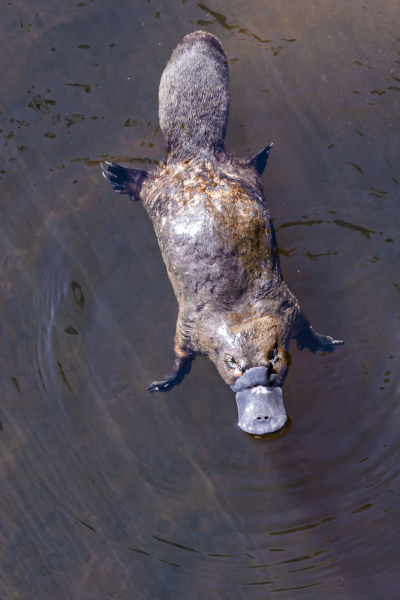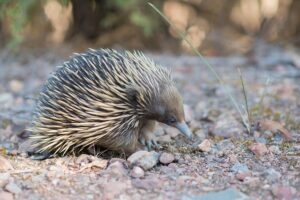
When we think of mammals, images of furry creatures giving live birth typically come to mind. However, monotremes break this mold, presenting a fascinating glimpse into the diversity of the animal kingdom. This small group of egg-laying mammals, which includes the Platypus(Ornithorhynchus anatinus) and echidnas offers insights into the complexities of reproductive strategies in the animal world. The story of monotremes is one of biological uniqueness, and the pressing need for conservation.
What Are Monotremes?
Monotremes represent a distinct subclass of mammals known as Prototheria. Monotremes are classified in the mammalian order Monotremata. The Platypus is classified in family Ornithorhynchidae and the four species of echidnas are classified in the family Tachyglossidae. The name “monotreme” derives from the Greek words “mono” meaning single and “treme” meaning hole, referring to the cloaca—a single opening used for excretion and reproduction. This singular feature sets monotremes apart from nearly all other mammals, which possess separate openings for these functions.
There are only five extant species of monotremes: the Platypus(Ornithorhynchus anatinus) and four species of echidnas, also known as spiny anteaters. While they share the common trait of laying eggs, each species has unique adaptations that suit their environments. The Platypus, for example, is semi-aquatic and has a bill that resembles that of a duck, while echidnas are covered in spines and have a long snout for foraging insects.

Unique Characteristics Of Monotremes
Egg-Laying: The most defining feature of monotremes is their method of reproduction. Unlike the vast majority of mammals, which are viviparous (giving birth to live young), monotremes lay eggs. These eggs are leathery rather than hard, similar to those of reptiles. After several weeks of incubation, the eggs hatch, and the mother nurses her young by secreting milk from mammary glands through openings in the skin.
Milk Production: Monotremes produce milk, but they lack nipples. Instead, the milk is secreted through openings in the skin.
Distinctive Anatomy: The Platypus is particularly notable for its duck-like bill, webbed feet, and flattened body, which make it an excellent swimmer. Echidnas, on the other hand, have spines covering their bodies, aiding in protection from predators, and a long tongue that extends to capture ants and termites.
Habitat
Monotremes inhabit diverse environments across Australia and New Guinea. The Platypus is commonly found in rivers, lakes, and streams, where it forages for insects and crustaceans. Echidnas, on the other hand, Echidnas are more terrestrial and can be found in forests, scrublands, and grasslands.
Conservation Status And Threats
As fascinating as monotremes are, they face significant threats that jeopardize their survival. Habitat destruction and human activities, such as agriculture and urban development, have led to the degradation of their natural environments. Pollution and the introduction of invasive species further compound these issues, making it increasingly difficult for monotremes to thrive. Efforts to protect these creatures include habitat restoration, conservation programs, and public education initiatives. Understanding the ecological role of monotremes is crucial in fostering appreciation for their preservation.
The Role Of Monotremes In Ecosystems
Monotremes play an essential role in their ecosystems. As predators, Platypuses help regulate insect and crustacean populations in aquatic environments. Their foraging behaviors contribute to the health of aquatic ecosystems, influencing food webs and nutrient cycling.
Echidnas, as insectivores, help control ant and termite populations, preventing these species from becoming overly abundant. Additionally, their digging behavior assists in soil aeration, which has positive effects on plant growth and overall ecosystem health.
Cultural Significance
Monotremes hold a special place in the cultural and natural heritage of Australia and New Guinea. The Platypus, in particular, has become an icon of Australian wildlife, celebrated in art, literature, and folklore. Aboriginal cultures have long revered these unique creatures, incorporating them into their stories and traditions.
Echidnas are also featured in Indigenous Australian stories, often symbolizing resilience and adaptability. This cultural significance underscores the importance of conserving these species not only for their ecological roles but also for their value in human history and identity.
Future Conservation Efforts
The conservation of monotremes requires a multifaceted approach that encompasses habitat protection, public education, and scientific research. Expanding protected areas and restoring degraded habitats are vital steps in ensuring the survival of these unique mammals. Additionally, engaging local communities in conservation efforts can foster a sense of stewardship and responsibility for their natural surroundings.
Public awareness campaigns highlighting the ecological importance of monotremes and the threats they face can inspire action and support for conservation initiatives. By educating people about the unique characteristics and vulnerabilities of monotremes, we can encourage greater appreciation for biodiversity and the need to protect it.
Conclusion
Monotremes are remarkable creatures that challenge our understanding of mammalian reproductive strategies. With their unique egg-laying methods and distinctive physical traits they offer a glimpse into the past and highlight the incredible diversity of life on Earth. However, the survival of these extraordinary animals is at risk due to habitat loss and environmental pressures.
By unlocking the secrets of monotremes, we not only enrich our knowledge of biodiversity but also emphasize the importance of conservation efforts. As we strive to protect these unique creatures and their habitats, we contribute to a larger movement aimed at preserving the intricate web of life on our planet. Every action counts in safeguarding our planet’s precious biodiversity.
